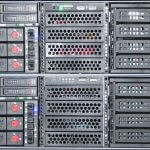Today I want to share how my home server from aliexpress looks and how I came to this configuration during the quarantine of 2020. To be completely honest, there are more components from aliexpress in the server than from other stores. Still, there are also Noctua, Thermaltake, and other brands more familiar to retail stores.
Also, this is the first post on this blog in English. I would appreciate any feedback on this matter.
For almost all my adult life, I kept a 24/7 computer at home. During my student years, this was my main and only computer. Later, when the energy-efficient Intel Atom and AMD Athlon II Neo became widespread, I became the happy owner of a pair of HP MicroServer G7s, which worked for many years.
However, one day the world began to be taken over by ARM-based processors and single-board computers. The Raspberry Pi, of course, led their legions. As you might guess, I also have several Raspberry Pi devices and even Orange Pi. The arrival of the Raspberry Pi 4B with 4 GB of RAM (recently released models with 8 GB) was a real boon for all IT-enthusiasts because this board has sufficient computing resources, for example, to deploy a full-fledged Kubernetes cluster. In general, the ARM architecture has become so popular that you can even buy VPS with ARM processors on the AWS platform.
It was from the time the Raspberry Pi 4B appeared that I had my own multi-node Kubernetes cluster at home, where several dozen applications were running, including this blog (but that’s a different story). But still, I wanted something more, I desired to deploy fault-tolerant storage, and for this, the Raspberry was not enough.
My new server from aliexpress
The component market analysis this spring showed that the most optimal in terms of price/performance ratio is the Intel Haswell platform, which widely represented on eBay / aliexpress. My choice fell on the following configuration. The price (USD) is approximate and indicated at the time of purchase.
| Type | Model | Specifications | Price |
|---|---|---|---|
| Motherboard | Huananzhi X99-F8 | LGA 2011-3, X99 (C612), 8 х DDR4 DIMM (ECC и non-ECC), 3 x PCI-e x16, 2 x PCI-e X1, 8 x SATA 3.0, 2 x M2 Nvme | 82 |
| CPU | Intel Xeon E5-2680 v3 | 12/24 cores/threads, 2.5 GHz, 30 MB cache, 120 W TDP | 96 |
| RAM | KLLISRE DDR4 16 Гб | 2400 MHz, ECC REG | 40 |
| LAN | Mellanox ConnectX-3 | PCI-e x8 (3.0), Dual SFP+ ports 10 Gb/s Ethernet | 48 |
| Controller | h1111z JMB585 | PCI-e x4 (3.0), 5 x SATA 3.0 | 16 |
| NVMe | KingSpec NE-256 | M.2 PCI-e NVME x4 (3.0), Read/Write 2400/1700 MB/s | 27 |
| SSD | KingSpec P3-1TB | SATA 3.0, Read/Write 570/540 MB/s | 75 |
 All this brilliance fitted perfectly into my existing Procase EB306S case (3U high, 480 mm deep) and supplemented by Seagate SV35 HDD drives and drive cages from my stock.
All this brilliance fitted perfectly into my existing Procase EB306S case (3U high, 480 mm deep) and supplemented by Seagate SV35 HDD drives and drive cages from my stock.
Two machines of this configuration become the main workhorses of my current home cluster, combining Kubernetes worker and ceph storage nodes roles. The NVMe drive used for ceph metadata and SSD and HDD used the data. Replication factor set to 2, don’t do this in production :-)
The cluster’s control nodes (Kubernetes masters and ceph mons) are a heterogeneous coalition on Raspberry Pi 4B and ESXi virtual machines. Ceph allows me to use persistent volumes in Kubernetes, and therefore stateful applications.
Afterword
For almost a month now, two servers from aliexpress have been working without any problems. I am most interested in how the disks will behave under load (and how the three-year warranty stated on them will work). I am 99.9% sure of the lifespan of the remaining component, especially since the CPU and RAM because they are original, only used.
I will update this post in case of any hardware problems.